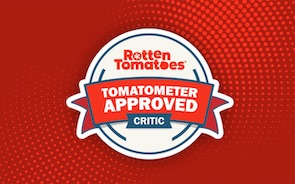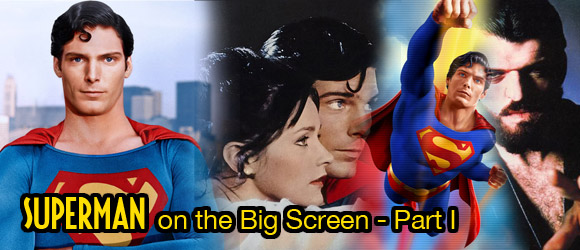
To celebrate the bravery of a new creative team, and a new actor, in the upcoming Man of Steel, we will explore all of the Superman films leading up to its release, and see if Henry Cavill can become Kalel of Krypton for a new generation.
THE DONNER ERA
It’s been 75 years since Jerry Siegel and Joe Schuster gave our world a saviour from a distant planet. His symbol is one of the most easily recognized in the world today. He is an icon, no longer solely associated with truth, justice, and the American way. Superman is truly universal, a symbol of hope, and it takes an extraordinary man to play him.
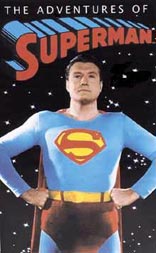 For a generation of TV goers, it was George Reeves. His suicide in 1959 at the age of 45 shocked the children of the world and ended a special relationship between that generation and the character. No one, it seemed, could embody the Man of Steel after him.
For a generation of TV goers, it was George Reeves. His suicide in 1959 at the age of 45 shocked the children of the world and ended a special relationship between that generation and the character. No one, it seemed, could embody the Man of Steel after him.
More than fifteen years would pass before another attempt would be made; this time not on the small screen but cinematically. Pioneer independent producers of the ilk of the Salkinds just don’t exist anymore. But back in the 70s, they were coming off a highly successful pair of movies based on Alexander Dumas’s The Three Musketeers novels. Their formula of filming two movies back to back, and acquiring the best talents their fortunes could muster, payed off handsomely. When talk began of what to do next, Alexander Salkind’s brash young son, Ilya, suggested Superman.
Millions of dollars and lengthy negotiations with DC Comics would follow, including a false start with famed Bond director Guy Hamilton for production in Italy. It wouldn’t be until Richard Donner, hot off the success of the horror classic The Omen, came onto the project, that the man responsible for a whole new generation of children falling in love with the character would be found.
New York stage actor Christopher Reeve, a tall, handsome 20 something, was always a favoured choice of casting director Lynn Stalmaster, but the producers were adamant that Kalel of Krypton should be played by a star. When every appropriate (and some inappropriate) choice rejected the offer, and the Salkinds managed to cast Marlon Brando and Gene Hackman for supporting roles, things began to change.
A strawberry blonde Reeve went to England, boot polish blacked his hair, stuck his skinny frame into a makeshift suit, and in seconds convinced everyone watching that Superman was standing in front of them. After that, no one else had a chance, despite an extensive search. Donner was taking a huge risk on the actor, who insisted his gangly frame could be built up quickly. Donner did the world a huge favour and believed him.
The lengthy and troubled production got underway. Donner took a massive script written by Godfather novelist Mario Puzo (and embellished by Salkind’ regular writers David and Leslie Newman), conscripted his friend and writer Tom Mankiewicz, and set to making the story emotionally resonant. According to Donner, the script that was intended to shoot was disrespectful, campy, and un-filmable.
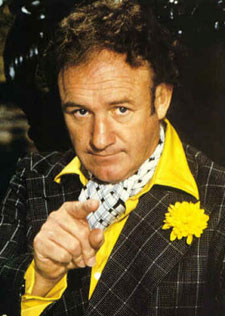 Despite millions having already been spent in pre-production, there was no convincing method of showing Superman fly; the production design from Italy was scrapped, and production of the proposed two movies would be moved to England’s Pinewood Studios. From the get go, money and time would be against Donner.
Despite millions having already been spent in pre-production, there was no convincing method of showing Superman fly; the production design from Italy was scrapped, and production of the proposed two movies would be moved to England’s Pinewood Studios. From the get go, money and time would be against Donner.
As production got underway, with Margot Kidder as Lois Lane, Mark McClure as Jimmy Olsen, and Jackie Cooper replacing heart attack victim Keenan Wynn as Perry White, Christopher Reeve had kept his word and bulked up to 212 pounds on his 6’4 frame. The main antagonist of the first film would be Lex Luthor, a role reluctantly accepted by Gene Hackman, and from all reports the cast and crew were convinced a great movie was being made.
But the Salkinds were business men first and foremost, and as the challenges of production kept lengthening principle photography and reducing the producer’s profit margin, tensions between them and their director turned acidic. It got so bad that Donner refused to speak with them and didn’t want them anywhere near his set. They sent in Musketeer’s director Richard Lester as a go-between, and a reminder to Donner he could be replaced. After going over schedule by months and exceeding the budget by millions, it was decided to halt principle photography. More than 80% of Superman 2 had been shot, including all the scenes involving Brando and Hackman, but the focus now would be on getting 1 to the finish line.
But even in editing, the war between Donner and the Salkinds continued. When Donner, through Warner Bros., wanted to test the film before audiences for his final edit, the Salkinds refused to release a print for the director to do so.
The tensions had not gone unnoticed by cast and crew, with Margot Kidder being particularly vocal and critical of the producers. In her words, they had hurt her beloved Donner, and she would have none of it. In fact most of the cast were absent from promotion, with only Sara Douglas being shipped around the world to talk about anything but the troubled production.
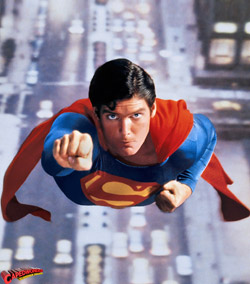 December 1978 saw Superman: The Movie debut to critical and commercial success. Donner’s adept handling of the gravitas and humour in the story delivered a crowd pleaser in spades. Box office quickly rose to over 300 million worldwide. Superman had delivered the first event super hero movie; its treatment of the character became the template for any filmmaker charged with bringing one of these larger than life characters into flesh. It became revered and considered seminal for the genre.
December 1978 saw Superman: The Movie debut to critical and commercial success. Donner’s adept handling of the gravitas and humour in the story delivered a crowd pleaser in spades. Box office quickly rose to over 300 million worldwide. Superman had delivered the first event super hero movie; its treatment of the character became the template for any filmmaker charged with bringing one of these larger than life characters into flesh. It became revered and considered seminal for the genre.
Contemporary views find certain elements of it quaint, and others, such as the ‘poem scene’ downright cringe-worthy, but something that immediately hooked audiences then and today was Christopher Reeve.
There was an engaging, emotional journey to be followed here. Superman: The Movie seamlessly transitioned from a science fiction picture to a small town idealism and then unleashed the bombastic for its’ bigger than life characters and finale.
From the moment that movie opened, Reeve was and always would be Superman. Donner had found an actor so committed and so organic to the role that he would make the audience believe Kalel of Krypton was flesh and blood. His immersion in the character is iconic, and as yet unmatched. It is Reeve that is ultimately responsible for the film’s reverence.
Donner had thought, after the successful release, that all would be forgotten between him and Salkinds – after all they now had some money in the bank, right? A quote he gave to Don Shay of Cinefantastique would end his time with the Man of Steel:
"I'd work with Spengler again, but only on my terms. As long as he has nothing to say as the producer, and is just liaison between Alexander Salkind and his money, that's fine. If they don't want it on those terms, then they need to go out and find another director, it sure as shit ain't gonna be me." –Richard Donner.
The Salkinds took offence to this public airing of the production’s difficulties. Donner was out (fired in a rather cowardly way by telegram) and Lester was in. Superman 2 would immediately go back into production and become another animal entirely.
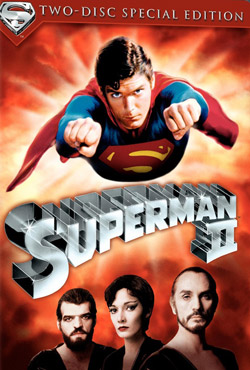 For years it was well known that, because of Director’s Guild rules, at least 70% of a film had to be shot under the direction of the same person(s) for it to be considered theirs. Lester reshot a lot of scenes for Superman 2 to adhere to that stipulation. So much of Donner’s Superman 2 sat in cans in vaults for years after.
For years it was well known that, because of Director’s Guild rules, at least 70% of a film had to be shot under the direction of the same person(s) for it to be considered theirs. Lester reshot a lot of scenes for Superman 2 to adhere to that stipulation. So much of Donner’s Superman 2 sat in cans in vaults for years after.
There was a vocal fan-base out there almost from the beginning for the Donner Cut, as it came to be known, to finally be assembled and shown to the world. As an attempt to restart interest in the Superman franchise finally came to fruition in the mid Noughties, and the home entertainment market was in boom, Warner’s approved the assemblage of Donner’s version for DVD/Blu Ray.
With a modest budget and the editing services of Michael Thau under Donner’s guidance, a completely new version of Superman 2 was assembled, reinserting Marlon Brando’s intended role and jettisoning as much of the Lester cut as possible. When Donner halted production back in 1977 he had completed all but a handful of scenes and the fight between Superman and the Kryptonian criminals. This new cut is a completely different version of the film than Lester’s, and ended up critically being on par in the eyes of the public. It is considered one of the best director’s cuts there is.
It is testament to Donner’s handling of the production that there is even cohesion, let alone a successful narrative to follow in this alternate sequel. About 83% of The Richard Donner Cut is Donner’s footage, but it was unavoidable that some of Lester’s would have to remain as well. This makes for some minor tonal imbalance, but it’s still a remarkably enjoyable film to sit through.
So 2006 finally saw an end to an unheard of timespan between a director and a franchise. Ask any director in Hollywood who did the best super hero film and who they hope to be like, and Donner is the name that will come up. Because of Richard Donner, Superman became reality, invaded out hearts, and showed the promise of many great adventures. But his greatest gift to the character was allowing Christopher Reeve to don the suit. With Reeve in the role, the possibilities were endless.
But it was not to be.
JOIN US NEXT TIME FOR SUPERMAN ON THE BIG SCREEN: THE LESTER ERA
Check out part 2 of the Superman series - Superman on the Big Screen Part 2: The Lester Era
Check out part 3 of the Superman series - Superman on the Big Screen Part 3: The Misfires
Check out part 4 of the Superman series - Superman on the Big Screen Part 4: A Fresh Start














